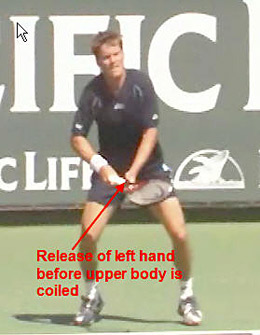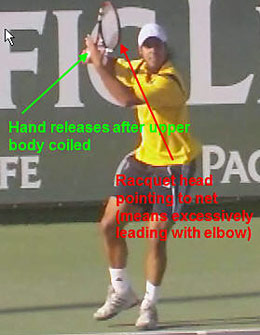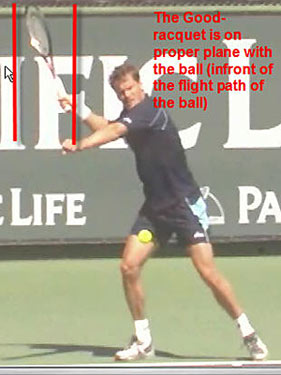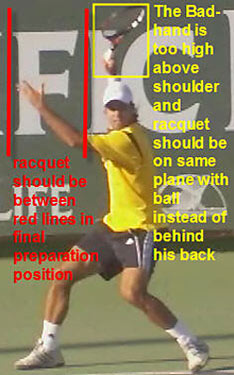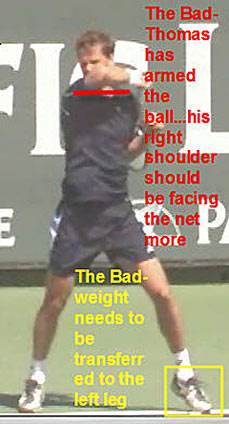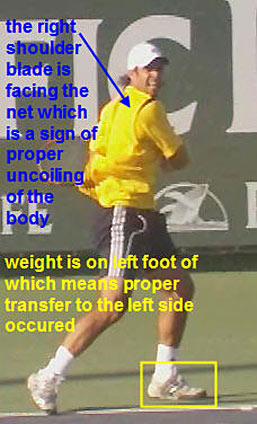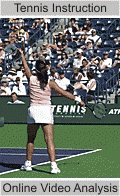TennisOne Lessons Forehand Fusion: Classical versus Millennium by Heath Waters I get many letters from novice and pro players alike asking about the millennium forehand and whether they should learn this forehand technique even if they have been hitting a classical style over the shoulder forehand for many years. The answer to this question quite simply depends upon what your goals are with your game, whether you have the desire to add a new shot to your current stroke repertoire, and how much time you have to practice. The millennium forehand without a doubt is the prominent forehand on the men's tour and is also the easiest way to learn how to hit topspin. If taught correctly it can be learned in only a matter of minutes. For those players who have their weekly singles and doubles matches already set up with their regular partners week in and week out and are content with their current level of play, there might not be much need to learn this forehand. However, I imagine if you are reading this article then you must have some sort of desire to improve your game; therefore, why not give it a shot.
I will share with you a quick story of encouragement. While I was coaching my wife at the Indian Wells professional tournament in California last month, I taught my first adult amateur player in 15 years (I have been coaching on the professional tour for the past eight years and have only coached professional or high level juniors since the early 90's). It was something I wanted and needed to do, as I wanted to see how quickly a student over the age of 50 years old could learn the millennium forehand technique. I knew high level players and very young junior players grasped the concept very quickly with immediate results, but I did not know how players who had been playing for years with their own cemented habits would acclimate to this technique. The test subject was an over fifty male named Joe. Joe, who was very open-minded and eager to learn this new technique so that he could add more topspin to his forehand along with his already penetrating forehand drive. Joe was a high B/low A level player and in great condition so I was very excited to get to work. I brought the video camera onto the court (this is the quickest way for any player and coach to learn by utilizing immediate visual feedback) and we went at it for two hours. I did not know what to expect but by utilizing The ACE System to achieve the same exact reference points that all the top forehands in the world achieve during the preparation, hitting zone, and ending of the stroke, within 15 minutes Joe had the millennium forehand technique down like he had been hitting it for 10 years! And believe me, he was like a kid in a candy store. He was so excited about adding this new stroke to his repertoire that we went another two hours the next day applying more of The ACE System to the other parts of his game, again using the video camera for instant visual feed back. The interesting thing; here was a guy supposedly stuck in his ways who was able to rekindle his excitement about his tennis game. So for you out there who might not be sure whether to try new things, let Joe be inspiration for you. You are always able to learn new things and get better as long as you remain open minded and willing. Forehand Fusion In today's article we will compare and contrast the forehands of two prominent tour players, Fernando Gonzalez and Thomas Enqvist. Gonzalez is known to have one of the heaviest (excessive topspin and velocity combination) forehands on tour and uses what I call the millennium forehand technique (pertaining to the stroke ending). Enqvist is known as a big hitting classical style (over the shoulder ending) baseliner. We will examine the good and the not so good aspects of each player's technique. Both of these players have big forehands but both could have more efficient technique if they swapped some of each other's key reference points. Enqvist is more biomechanically efficient with his preparation but Enqvist could utilize the use of the body more like Gonzalez. Using The ACE System we will show you that by means of fusing the positive technical elements of each of these players forehands together, we can derive a more efficient biomechanically sound forehand where both styles meet somewhere in the middle. You can then take the positive elements from each of these two forehands and apply them to your own forehand. So let's get started. The Unit Turn
The first reference point to look at is the use of the left hand during the preparation phase of the stroke. Notice when each player let's go of the racquet with the left hand when going into the preparation phase of the stroke. This is important because the left hand and arm are instrumental in helping ensure proper upper body coil as one achieves their final preparation position. As you see illustrated in the pictures above, Enqvist lets go of the racquet with his left hand well before he coils the upper body, and Gonzalez lets go of the racquet well after his left shoulder or upper body is coiled and sideways to the net. Keeping the left hand on the racquet until you are coiled like Gonzalez will be the reference point keeper for our fusion forehand. Letting go of the racquet with the left hand too early as Enqvist does can lead to technical issues for many novice players and pros alike. Keeping the left hand on the racquet until one is coiled near 90 degrees to the net and the hands are in front of the chest is a great kinetic reference point for you to feel for when executing your preparation. Although almost all the top players keep their left hand on the racquet longer than Enqvist, he continues to keep the left arm in proper position (achieving parallel to the net) and gets the upper body coiled as he goes into his final preparation position. So in this particular instance Enqvist letting go of his racquet early does not cause any major technical issues.
The Take Back The second reference point is the use of the right elbow. In all the best forehands of today you will see every player lead with the elbow (rather than with the racquet head) to some degree when taking the racquet back into their final preparation position. A common error in racquet preparation is to lead with the racquet head as you take the racquet back. This can cause the racquet head to go off plane or go behind the back when achieving the final preparation position. Leading with the elbow helps keep the racquet head in what I call the "slot" or on plane with the flight path of the ball. You will, however, see many variations of this leading elbow in the top forehands. Roddick and Sampras, as well as Gonzalez and Enqvist (as you can see in the videos) are on the exaggerated side of leading with the elbow. Gonzalez leads with the elbow ever so slightly more than Enqvist but not much.
I teach and prefer the more simplified version of leading with the elbow such as Federer, Safin, and Agassi execute, as it is easier to catch the racquet head up with the ball if for any reason you are a bit late on your preparation. My philosophy has always been, the more simple technique the less that can go wrong with it. Leading with the elbow to the extent that Enqvist, Gonzalez, Sampras, and Roddick do unnecessarily adds another link to the timing chain and one more added step could be the difference between producing one more or one less ball over the net. My goal is to always derive the most efficient biomechanically sound technique, one that is less likely to breakdown under duress. The exaggerated elbow lead into the preparation works well for rhythm purposes, on balls one has time to set up for, and it can create a whip like action, but it can cause timing problems if balls are blazing at you at mach 1. There's a tendency to be late to impact due to the lazy drag of the racquet head into the final preparation position. So to sum up, it is important to lead with the elbow but ever so slightly as Federer, Safin, and Agassi do. I do not recommend nor believe that leading with the elbow to the extent of Gonzalez or Enqvist is as biomechanically efficient and all too often this technique can lead to timing issues when facing higher velocity balls. The third reference point to examine is the final preparation position of both players. Look at the preparation of Fernando Gonzalez! You can see why this forehand can be one of the biggest on tour as he takes his hand so high (this will allow for more racquet speed), but his preparation from left hand release to final preparation position is extremely inefficient.
Look at the right hand in the Super Slow-Mo video as he inverts his hand and it actually travels over his head before settling into his final preparation position. Needless to say, this is a very big loop back swing and also very biomechanically inefficient. One can clearly see how, with such an exaggerated back swing, Gonzalez can generate enormous amounts of topspin and power, but you can also see why his forehand is not as consistent as Federer's, Agassi's, or Safin's. Simply put, his backswing goes offline, is too high, and this allows for too many things to inevitably go wrong before contact is made. His timing has to be perfect in order to meet the ball at the same contact point each and every time. This is a tall task, but when he times the ball accurately, he definitely hurts his opponents with his heavy combination of speed and spin. Unfortunately, he has not been able to reproduce this big forehand often enough to reach the top 10 in the world yet. It would be wise of him to adjust his preparation, copying the more efficient take back of Enqvist by slightly lowering the final preparation position of the right hand and by keeping the racquet head on plane with the flight path of the ball. So for this reference point we will want to mimic Enqvist's final preparation position and add it to our "Fusion Forehand" rather than the big looping, over the head, and offline back swing of Gonzalez.
The Finish The fourth reference point and the final one we will discuss is the ending of the forehand stroke. Although Enqvist had a more efficient preparation, Gonzalez without a doubt utilizes his body during the stroke much more effectively than Enqvist. As you will see in the illustrated graphics above, Enqvist, after the preparation phase, basically arms the ball without uncoiling or transferring his weight from the right side of the body to the left side. His weight is still on his right foot during the ending phase of the stroke and we can still see Enqvist's chest after he ends his forehand stroke. This is an indication that Enqvist did not effectively uncoil his body into the shot. So the keeper for this particular reference point we will take the more Gonzalez, on the other hand, uses a far more efficient and effective ending. Notice that after uncoiling his body, his right shoulder blade is facing the net and all his weight has been transferred to his left leg. His racquet head finishes by his hip or side of the left elbow (millennium ending). A far more effective ending for our fusion forehand.
We have now deduced the more efficient reference points from the two different style forehands of Thomas Enqvist and Fernando Gonzalez and have come up with the following elements consisting of these reference points.
So there you have it. By comparing and contrasting these two forehands we have derived the most efficient biomechanical aspects from each and have now created our "Fusion Forehand". You can now take the reference points for this "Fusion Forehand" and apply them to your own game. Remember, just because these players are professionals, does not mean that they cannot acquire more efficient technique. If we can learn to see the strengths in others then just maybe we can learn from these strengths and apply them to our own games in order to improve our weaknesses and reinforce our strengths. Click player to view complete, full size T1 Super Slow-Mo Video: Thomas Enqvist - Fernando Gonzalez Your comments are welcome. Let us know what you think about Heath Waters' article by emailing us here at TennisOne.
This invaluable visual comparison, combined with the detailed analysis by a current tour professional coach, offers the most advanced and unique learning environment in tennis. Pro Tech will store your video lessons for two years on your own web page, so you and your coach can evaluate your progress from anywhere in the world. TennisOne members receive a 10% discount. |
|||||||||||||||||

